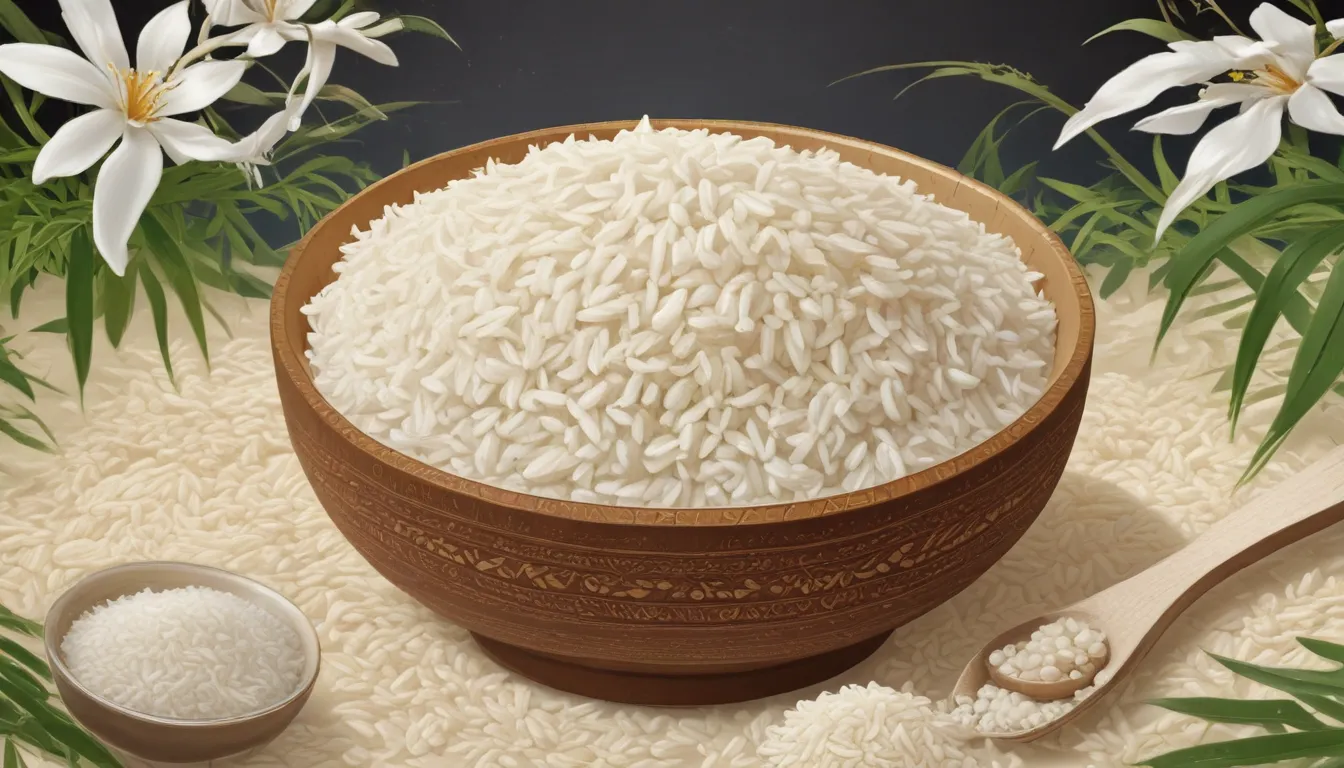The pictures in our articles might not always show exactly what the text is talking about. We use these images to make the article more interesting and eye-catching. They are there to add to the text, but not to replace it or show every detail.
Are you a food lover, a cooking enthusiast, or just curious about different types of rice? If so, get ready to dive into the delightful world of jasmine rice! This popular variety of rice, known for its floral aroma and fluffy texture, has captured the hearts of many around the globe. From its origins in Thailand to its versatile culinary uses, jasmine rice is truly a unique grain that offers a variety of benefits. In this article, we will explore 15 fascinating facts about jasmine rice that will enhance your knowledge and appreciation for this versatile grain. So, grab a bowl of rice and let's get started on our journey of discovery!
The Origins of Jasmine Rice
Jasmine rice, also known as Thai fragrant rice, is primarily grown in Thailand. Cultivated for centuries, jasmine rice is an integral part of Thai cuisine and has gained popularity worldwide for its unique characteristics.
The Aromatic Flavor of Jasmine Rice
Jasmine rice gets its name from its distinct floral aroma reminiscent of jasmine flowers. This fragrant quality adds a delightful taste and aroma when cooked, making jasmine rice a favorite in many kitchens.
The Long Grain of Jasmine Rice
Jasmine rice features long grains that are slender and separate easily after cooking. The fluffy texture of jasmine rice makes it perfect for dishes like stir-fries, curries, and pilafs.
Versatile Cooking Methods for Jasmine Rice
Whether you prefer cooking jasmine rice on the stovetop, in a rice cooker, or using the absorption method, this grain is well-suited for various cooking techniques and yields consistently delicious results.
The Nutritional Value of Jasmine Rice
Jasmine rice is a good source of essential nutrients such as carbohydrates, fiber, protein, and minerals like magnesium and phosphorus. It offers a healthy option for those looking to incorporate nutritious grains into their diet.
Gluten-Free Nature of Jasmine Rice
Jasmine rice is naturally gluten-free, making it a safe alternative for individuals following a gluten-free diet due to gluten sensitivities or celiac disease. This grain provides a versatile and delicious option for those with dietary restrictions.
Jasmine Rice in Asian Cuisine
Jasmine rice is a staple in many Asian cuisines, including Thai, Vietnamese, and Chinese. Its ability to complement a wide variety of dishes makes it a popular choice for cooks and food enthusiasts alike.
Flavor Absorption of Jasmine Rice
Due to its porous nature, jasmine rice readily absorbs the flavors of the ingredients it is cooked with, enhancing the overall taste of the dish. This makes jasmine rice a versatile and flavorful addition to any meal.
Jasmine Rice for Desserts: Fragrant Rice Pudding
Jasmine rice can also be used to make delicious desserts like rice pudding. Its natural fragrance adds a unique twist to this classic sweet treat, making it a delightful and aromatic dessert option.
Health Benefits of Jasmine Rice
In traditional medicine, jasmine rice is believed to have several health benefits, including soothing the digestive system and aiding in relieving anxiety and stress. Incorporating jasmine rice into your diet may offer additional health benefits along with its delicious flavor.
Worldwide Export of Jasmine Rice
Thailand, the largest producer of jasmine rice, exports this fragrant grain to countries all over the world. Its unique taste and aroma have captured the attention of food enthusiasts worldwide, satisfying the demand for this versatile grain.
Cooking Tips for Perfect Jasmine Rice
To ensure the perfect texture and aroma of jasmine rice, rinse the grains before cooking to remove any excess starch. Use a ratio of 1.5 cups of water per cup of rice to achieve fluffy and aromatic jasmine rice every time.
Jasmine Rice in Thai Cuisine
In Thai cuisine, jasmine rice is commonly served alongside flavorful dishes such as green curry, pineapple fried rice, and pad Thai. Its aromatic flavor and fluffy texture make it a perfect accompaniment to a wide range of Thai dishes.
Shelf Life and Varietals of Jasmine Rice
To keep jasmine rice fresh, store it in an airtight container in a cool and dry place. Proper storage can extend the shelf life of jasmine rice for up to a year. Additionally, there are different types of jasmine rice, each with its own unique characteristics in terms of flavor and texture.
In conclusion, jasmine rice is a versatile and popular grain enjoyed by many around the world. Whether you're cooking a traditional Thai dish or experimenting with new recipes, jasmine rice offers a unique culinary experience. Its aromatic fragrance, fluffy texture, and ability to absorb flavors make it a versatile and delightful addition to any meal.
So, the next time you're in the mood for rice, why not give jasmine rice a try? Its delightful aroma and delicious flavor will surely elevate your dining experience and leave you craving more. Embrace the wonderful world of jasmine rice and discover the endless possibilities it offers in your kitchen!
Frequently Asked Questions about Jasmine Rice
- How is jasmine rice different from other types of rice?
-
Jasmine rice stands out for its distinct floral aroma and soft, sticky texture when cooked. It has a delicate flavor that pairs well with a variety of dishes, making it a popular choice for many cuisines.
-
Is jasmine rice a healthy option?
-
Jasmine rice is a good source of carbohydrates and provides essential nutrients. It is naturally gluten-free and has a lower glycemic index compared to other types of rice, making it a suitable choice for those managing their blood sugar levels.
-
How do I cook jasmine rice?
-
To cook jasmine rice, rinse the grains under cold water to remove excess starch. Use a 1:1.5 ratio of rice to water, bring to a boil, then simmer for 15-20 minutes until the water is absorbed. Fluff with a fork before serving.
-
Can I substitute jasmine rice with other types of rice?
-
While jasmine rice has unique characteristics, you can substitute it with other long-grain rice varieties such as basmati rice or long-grain white rice. Adjust cooking times and methods to suit the different flavors and textures.
-
Is jasmine rice suitable for vegans and vegetarians?
- Yes, jasmine rice is suitable for vegans and vegetarians as it is plant-based and free from animal products. Enjoy it as a main dish or as a side alongside various vegan and vegetarian recipes.
Experience the joy of cooking with jasmine rice and savor the aromatic fragrance and delightful taste it brings to your meals. Whether you're a seasoned chef or a novice in the kitchen, jasmine rice offers a world of culinary possibilities waiting to be explored. Embrace the versatility and flavor of jasmine rice in your cooking and elevate your dining experience with this beloved grain.






